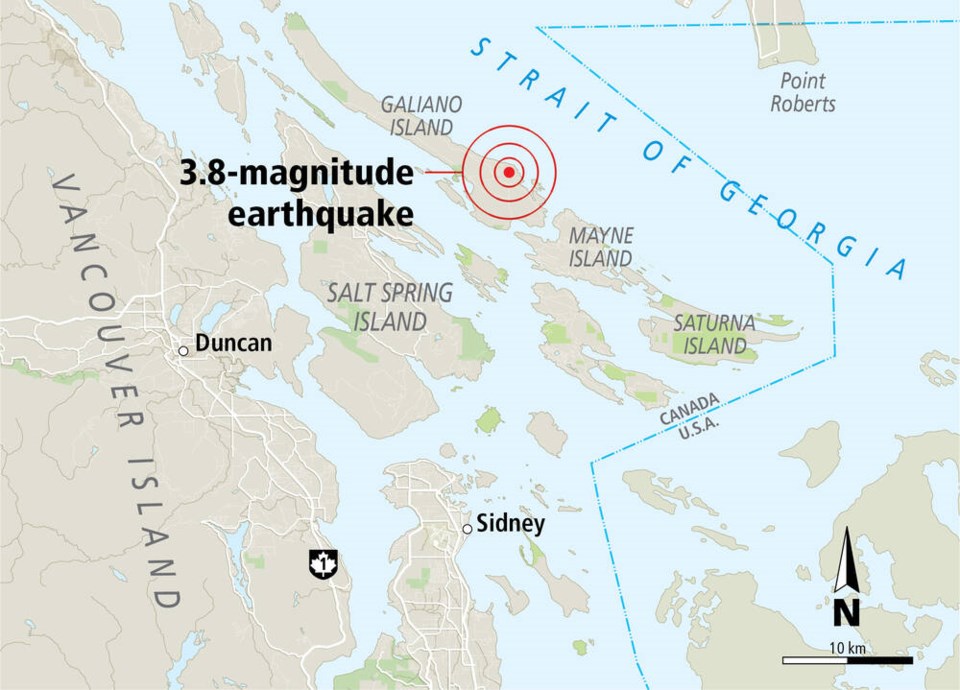When the earthquake struck early Friday, Jamie Neilson was reviewing basketball game video in the basement of his Dean Park home. “I thought somebody upstairs fell out of bed,” he said.
Rob Freeman, who lives in Saanich near the Vancouver Island Regional Correctional Centre on Wilkinson Road, told the Times Colonist his green-eyed black cat Milly woke him up “before a big thud that rattled the windows.”
On Friday at 4:13 a.m., a magnitude 3.8 earthquake beneath Galiano Island was felt by humans and pets throughout the capital region, south Island, Gulf Islands and Metro Vancouver.
The quake struck 12 kilometres east-northeast of Ganges at a depth of 17.3 kilometres, the U.S. Geological Survey reported.
Natural Resources Canada seismologist John Cassidy says it’s the largest quake to shake the Island this year — southwestern B.C. typically has “tiny earthquakes” every day.
The last big one locally was a 4.7-magnitude quake off Sidney in December of 2015. “The main takeaway is, really, a friendly reminder that we live in an active earthquake zone,” said Cassidy, adding a large one could strike any time.
There were no reports of damage as a result of Friday’s earthquake.
Residents of Colwood, the Saanich Peninsula, Sooke, Esquimalt, Duncan and North Cowichan, Salt Spring Island and Saturna Island were among those who reported mostly a “weak” rumble to Natural Resources Canada’s earthquakescanada.nrcan.gc.ca site.
Sue Campbell, who lives on Dallas Road near Ogden Point, said the quake woke her up “with the house shuddering.” Sharon White in View Royal thought a large truck was passing by.
In Lantzville, immediately north of Nanaimo, Lynda Williams said her parents’ house creaked “and a little bedside lamp rattled.”
“Shook my apartment a good one,” one person posted on Twitter. “My bed shook and I was out of it in two seconds,” another said.
Others described the quake as sounding like a door slamming or the house groaning or shifting, or as if a heavy vehicle were approaching.
Cassidy said a study following the 2001 Nisqually 6.8-magnitude earthquake, centred in Puget Sound near Seattle and felt in Victoria, found those who lived on soft soil —“and there’s a lot of little pockets of soft soil around Victoria” — were more likely to feel a stronger shaking for a longer time.
Those who live on bedrock didn’t feel nearly as much shaking, said Cassidy.
“That’s often the rule of thumb, that it’s the geology that plays an important factor — and the geology across Victoria and even across a city block changes — so it’s quite variable.”
Cassidy said one interesting finding on Friday was that people reported feeling both the primary or pressure seismic wave, known as the P-wave — the fastest-travelling seismic wave that causes abrupt up and down shaking — and the shear or secondary seismic wave, a slower-travelling back and forth shaking that causes more damage, from knocking items off shelves to significant disruption.
“Many people actually reported feeling both of those waves — two jolts,” said Cassidy.
Friday’s quake is a good reminder to take stock of one’s earthquake preparedness at home, Cassidy said. “Being prepared can make a huge difference and there’s lots of resources out there on how to put together an earthquake kit,” he said. “There’s a lot of little simple things you can do.”
To make your earthquake preparedness kit or go online to:



